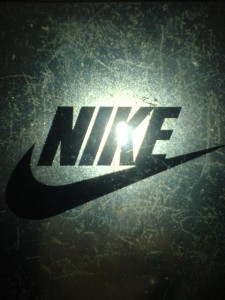How do you sell a product no one needs? Create a problem that no one has and convince them that its a problem. While thinking about how I wanted to finish off my 10th post about marketing, I was wondering to myself what would be a good way to finish off my blog. I came to the conclusion at around 3:30 AM last night while watching the “Magic Bullet” informercial for the 132nd time. Some products when you see them makes you wonder what kind of individuals would be interested in buying them. Obviously as Marketing students, we’re just way too clever to fall into their marketing schemes. Here are the top items on my list of Useless Products with Effective Marketing.
1.) Go-Girl (Female Stand-up Urination Device)
 This product was brought up in my marketing class and therefore gets first honours. First, I just want to point out that I’m going to pretend this product isn’t horribly disgusting. Besides that, I don’t think I know a single girl who would want to own this device. And if you do, let me know as I can no longer associate with you. This device is useless, as the pee apparatus you were born with is fine and I don’t see why you would need to improve on that. So far this product has been a hit at trade shows. My guess is that its mostly for some poor joke birthday/wedding gifts.
This product was brought up in my marketing class and therefore gets first honours. First, I just want to point out that I’m going to pretend this product isn’t horribly disgusting. Besides that, I don’t think I know a single girl who would want to own this device. And if you do, let me know as I can no longer associate with you. This device is useless, as the pee apparatus you were born with is fine and I don’t see why you would need to improve on that. So far this product has been a hit at trade shows. My guess is that its mostly for some poor joke birthday/wedding gifts.
2.) Snuggie
This product really demonstrates the laziness and improvements of comfortability that we are now discovering. I would love to meet the individual who came up with this. This blanket is comfortable, portable and not exactly socially acceptable. But at the very least, your arms will remain warm and you’ll never have to get tangled in your blankets ever again. Also, according to the below commercial, you will save money on heating.

3.)Facial Flex
When I first heard about this product, I thought it was a joke. However, it most definitely is real. This product is targeted towards those work-out junkies who want a ripped jawline or those individuals who don’t get out much and actually think these braces substitutes are actually going to improve the shape they’re in.

These are just three examples of useless products with effective marketing. It just goes to show that one need not have a good idea in order to make money off of it. Just a good marketing strategy and excellent targeting of the stupid demographic.

 After recently getting into an in-class argument with someone who was fed up with product placement, I thought I would demonstrate an example of how some companies are turning the tables. “The Black Mamba” is a short film featuring Kobe Bryant, Robert Rodriguez as the director, Bruce Willis, Danny Trejo, Kanye West and a myriad of basketball stars. The 6 minute film follows a story arc of Robert Rodriguez pitching a movie idea to Kobe Bryant, which eventually culminates in him facing off against the Boss (Kanye West) and his cronies (basketball stars). Because of the Black Mamba’s superior shoes (see above picture) and his ability to shoot down a helicopter with a basketball, he eventually defeats the Boss and becomes a legend.
After recently getting into an in-class argument with someone who was fed up with product placement, I thought I would demonstrate an example of how some companies are turning the tables. “The Black Mamba” is a short film featuring Kobe Bryant, Robert Rodriguez as the director, Bruce Willis, Danny Trejo, Kanye West and a myriad of basketball stars. The 6 minute film follows a story arc of Robert Rodriguez pitching a movie idea to Kobe Bryant, which eventually culminates in him facing off against the Boss (Kanye West) and his cronies (basketball stars). Because of the Black Mamba’s superior shoes (see above picture) and his ability to shoot down a helicopter with a basketball, he eventually defeats the Boss and becomes a legend.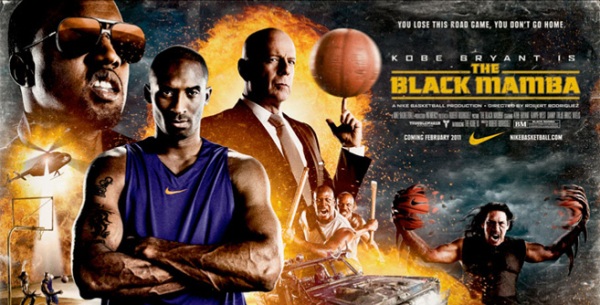 Instead of Nike associating the shoes with their spokesperson, they have associated their spokesperson with these shoes. It is an incredibly detailed story that Nike has created in order to encourage interest from consumers and it works. The ad has gone viral, with almost 3,000,000 hits when this article was posted. They have done more than creating a persona around their product, they have created a legend around their product. This definitely seems to be a developing trend in many marketing strategies as traditional advertising seems to be losing its appeal and the attention of the public. What better way to get someone interested in your product than to make them want to watch your ad. The cinematic quality and the presentation of the film makes it more than just a regular advertisement. This is more than just about shoes, this is about Nike conveying the basketball culture and lifestyle to its consumers. But enough out of me, take a look for yourselves.
Instead of Nike associating the shoes with their spokesperson, they have associated their spokesperson with these shoes. It is an incredibly detailed story that Nike has created in order to encourage interest from consumers and it works. The ad has gone viral, with almost 3,000,000 hits when this article was posted. They have done more than creating a persona around their product, they have created a legend around their product. This definitely seems to be a developing trend in many marketing strategies as traditional advertising seems to be losing its appeal and the attention of the public. What better way to get someone interested in your product than to make them want to watch your ad. The cinematic quality and the presentation of the film makes it more than just a regular advertisement. This is more than just about shoes, this is about Nike conveying the basketball culture and lifestyle to its consumers. But enough out of me, take a look for yourselves.
 They get to be first because this is what caused the epiphany in the first place. Nothing satisfies more than a Guinness or 12 on St. Patricks day and the Irish brand has a strong association with this semi-holiday (well its real in Newfoundland, Labrador and Ireland!) around the world. This association works wonderfully with an alcoholic beverage since that is what is major activity on this day, I’m not sure of the origins of this holiday so I just always assumed St. Patrick was an alcoholic who liked to yell Lá Fhéile Pádraig Sona Duit! at everyone he would meet. Notable Challenger: Jameson Whiskey.
They get to be first because this is what caused the epiphany in the first place. Nothing satisfies more than a Guinness or 12 on St. Patricks day and the Irish brand has a strong association with this semi-holiday (well its real in Newfoundland, Labrador and Ireland!) around the world. This association works wonderfully with an alcoholic beverage since that is what is major activity on this day, I’m not sure of the origins of this holiday so I just always assumed St. Patrick was an alcoholic who liked to yell Lá Fhéile Pádraig Sona Duit! at everyone he would meet. Notable Challenger: Jameson Whiskey. I cannot think of a more well-publicized, single event sponsored by and associated more with a single brand than Macy’s Thanksgiving Day Parade in New York. The most popular parade in America since 1924, 3.5 million people turn out in the streets and more than 50 million tune in worldwide to watch. A long standing tradition that demonstrates the roots of the company, I’d say this is the best advertisement a company could hope for outside of being a national landmark.
I cannot think of a more well-publicized, single event sponsored by and associated more with a single brand than Macy’s Thanksgiving Day Parade in New York. The most popular parade in America since 1924, 3.5 million people turn out in the streets and more than 50 million tune in worldwide to watch. A long standing tradition that demonstrates the roots of the company, I’d say this is the best advertisement a company could hope for outside of being a national landmark. Purdy’s easter chocolates have definitely become a staple, at least in my household, and they now offer an
Purdy’s easter chocolates have definitely become a staple, at least in my household, and they now offer an  Hallmark has become the go-to company for holidays. Coming as almost an afterthought, these cards are associated with every major holiday and every special occasion under the sun. “Hallmark Holidays” is a negative term used to associate the company with making up holidays for a purely commercialized basis instead of actually having a purpose. Most of these have been included above, but I’m sure as I write this Hallmark execs are developing more reasons to purchase cards on a regular basis.
Hallmark has become the go-to company for holidays. Coming as almost an afterthought, these cards are associated with every major holiday and every special occasion under the sun. “Hallmark Holidays” is a negative term used to associate the company with making up holidays for a purely commercialized basis instead of actually having a purpose. Most of these have been included above, but I’m sure as I write this Hallmark execs are developing more reasons to purchase cards on a regular basis. In Karolina Nowak’s post “
In Karolina Nowak’s post “ Furthering my post on the power of twitter, comes the companies that are currently making money off these people. Advertising companies such as
Furthering my post on the power of twitter, comes the companies that are currently making money off these people. Advertising companies such as  Charlie Sheen in particular is quite the catch for the company, as he recently broke a Guinness book of World Record by getting 1,000,000 followers in 25 hours on Twitter and currently has over 2,000,000. (I guess
Charlie Sheen in particular is quite the catch for the company, as he recently broke a Guinness book of World Record by getting 1,000,000 followers in 25 hours on Twitter and currently has over 2,000,000. (I guess 



 Because the current one we have in the sub is like half a subway that takes twice as long to make you a sandwich and doesn’t follow any of their sweet promotions (i.e
Because the current one we have in the sub is like half a subway that takes twice as long to make you a sandwich and doesn’t follow any of their sweet promotions (i.e 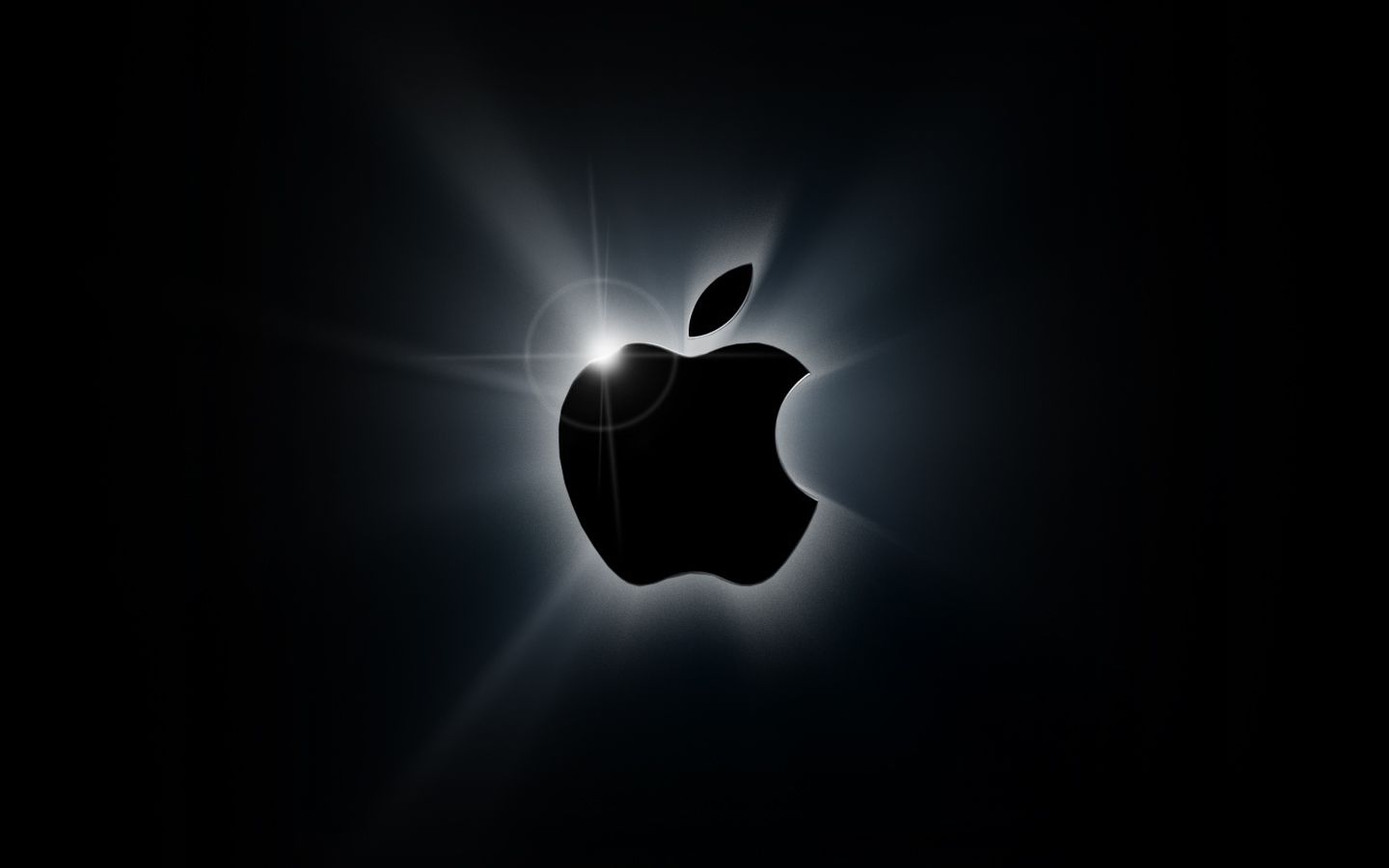 If my marketing class has taught me anything, its that 4/5 of their entire customer base goes to UBC. I don’t want to have to go downtown/to Oakridge to have to get my keyboard cleaned. They already have a sales staff at the Bookstore, just incorporate the IT into it. Can’t be too hard.
If my marketing class has taught me anything, its that 4/5 of their entire customer base goes to UBC. I don’t want to have to go downtown/to Oakridge to have to get my keyboard cleaned. They already have a sales staff at the Bookstore, just incorporate the IT into it. Can’t be too hard.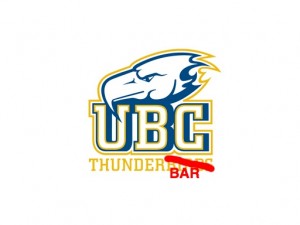
 I know what you’re thinking. We already have 2 Tim Hortons, we have 6 Starbucks and many other coffee houses. Why would we ever need another coffee house on campus. Well, I’m talking a real Tim Hortons. Not these ridiculous only-serving-frozen-baked-goods-and-coffee-close-at-4 o’clock Tim Horton’s that exist in the Forestry building and below David Lam. These are a sham of the great organization and quite frankly an embarrassment to it. I didn’t realize I had such a brand loyalty to this piece of Canadiana until I saw the price tag of coffee at Starbucks and others. Then I quickly became a crusader of fighting the good fight and seeingthis to the end.
I know what you’re thinking. We already have 2 Tim Hortons, we have 6 Starbucks and many other coffee houses. Why would we ever need another coffee house on campus. Well, I’m talking a real Tim Hortons. Not these ridiculous only-serving-frozen-baked-goods-and-coffee-close-at-4 o’clock Tim Horton’s that exist in the Forestry building and below David Lam. These are a sham of the great organization and quite frankly an embarrassment to it. I didn’t realize I had such a brand loyalty to this piece of Canadiana until I saw the price tag of coffee at Starbucks and others. Then I quickly became a crusader of fighting the good fight and seeingthis to the end.
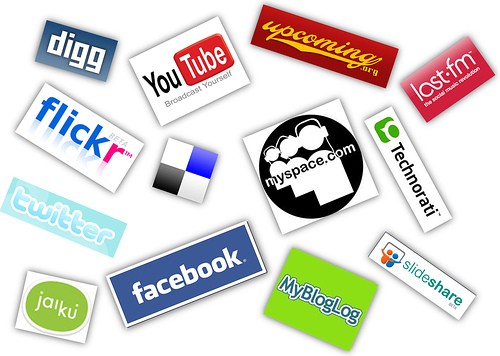 emphasis placed on things such as LinkedIn, Twitter, untagging yourself in compromising photos on Facebook and even the importance of blogs. AKA – Social Media Marketing. In Commerce 296, the importance of these websites are held to high esteem and its even been suggested that this is the future of networking, marketing and job hunting. In fact, one of the blogs was recently quoted in a local newspaper! But a number of things have come to my attention that point out some holes in the idea that these are now necessary components of the business world.
emphasis placed on things such as LinkedIn, Twitter, untagging yourself in compromising photos on Facebook and even the importance of blogs. AKA – Social Media Marketing. In Commerce 296, the importance of these websites are held to high esteem and its even been suggested that this is the future of networking, marketing and job hunting. In fact, one of the blogs was recently quoted in a local newspaper! But a number of things have come to my attention that point out some holes in the idea that these are now necessary components of the business world..jpg)
 Especially with a number of these companies about to start offering IPO’s in the near future, (doesn’t it seem disconcerting that Facebook is valued higher than Time Warner, Newscorp and eBay already?) the time to wonder is now. People stand to make a fortune or lose millions and it all depends on whether social media is here to stay.
Especially with a number of these companies about to start offering IPO’s in the near future, (doesn’t it seem disconcerting that Facebook is valued higher than Time Warner, Newscorp and eBay already?) the time to wonder is now. People stand to make a fortune or lose millions and it all depends on whether social media is here to stay.